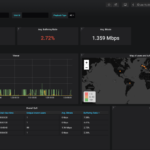Kabbage secures $200M to fuel its AI-based loans platform for small businesses
Kabbage, the AI-based small business loans platform backed by SoftBank and others, is adding more firepower to its lending machine: the Atlanta-based startup has secured an additional $200 million in the form of a revolving credit facility from an unnamed subsidiary of a large life insurance company, managed and administered by 20 Gates Management, and Atalaya Capital Management.
The money comes on the heels of a $700 million securitization Kabbage secured just three months ago and it is notable not just for its size but its terms: it’s a four-year facility, a length of time that underscores a level of confidence in the company’s performance.
Kabbage, which loans up to $250,000 in a single deal to small and medium businesses, has built a platform that harnesses the long tail of big data from across the web. It uses not just indicators from a company’s own public activities, but also sources comparative information from across a wider group of similar companies, with “2 million live data connections” currently helping to feed its algorithm.
Together, these help Kabbage determine whether to provide the loans, and at what rates. Notably, the whole process takes mere minutes, making Kabbage disruptive to the traditional route of applying for loans from banks, which can come at higher rates, often take longer to close and may never get approved.
The company was last valued at $1.2 billion in its most recent equity round from the Vision Fund in 2017, with about $500 million raised in equity to date from it and other investors, including BlueRun Ventures and Mohr Davidow Ventures. Rob Frohwein, the co-founder and CEO, confirmed to me via email that there are “no plans on the equity side right now.” We’ve asked about IPO plans and will update if we learn anything more on that front.
More importantly, alongside its equity story is the company’s business story: Kabbage has to date loaned out $7 billion in capital — amassed through securitizations and other facilities alongside that — to 185,000 businesses, and the company has seen an acceleration of business activity over the last two years. Nearly $700 million was loaned out in Q2 of this year, passing the record in Q1 of $600 million. This puts Kabbage on track to loan out between $2.4 billion and $3 billion this year.
“This transaction further diversifies Kabbage’s committed sources of funding and prepares us to meet the escalating demand for capital access among small businesses,” said Kabbage head of Capital Markets, Deepesh Jain, in a statement. “2019 has proven to be a tide-shifting year as customers accessed more than $670 million from Kabbage in Q2 2019, well surpassing our previously set record last quarter.”
While a lot of Kabbage’s business has come out of its direct consumer relationships, it’s also been expanding by way of more third-party relationships. It has white-label partnerships with banks to power their own loan offerings for SMBs, and earlier this year it was also tapped by e-commerce giant Alibaba to provide loans to its small business customers of up to $150,000 to help finance purchases, part of the latter company’s redoubled efforts to build out its business in the U.S. by way of its quiet acquisition of OpenSky.
Powered by WPeMatico
Equinix and Singapore’s GIC will launch a $1 billion joint venture to build hyperscale data centers in Europe
Equinix, one of the world’s largest data center companies, announced that it will form a $1 billion joint venture with GIC, Singapore’s sovereign wealth fund. The partnership will focus on building xScale data centers in Europe. Instead of targeting the wholesale market, Equinix is developing xScale data centers to handle the demands of the biggest cloud service providers in the world. Equinix’s clients have already included Alibaba Cloud, Amazon Web Services, Microsoft Azure, Oracle Cloud Infrastructure, Google Cloud and other hyperscale cloud providers.
Under the agreement, expected to be finalized in the third quarter, GIC will own an 80% stake in the joint venture, with Equinix owning the remaining 20%. Equinix will also sell its London LD10 and Paris PA8 International Business Exchange (IBX) data centers to the joint venture for new xScale centers. xScale centers will also be built in Amsterdam, Frankfurt and London, bringing the total to six centers that will provide a combined capacity of 155 megawatts once completed.
Equinix says global deployments from hyperscale cloud providers currently exceed about $500 million in annual revenue. The new xScale data centers will be located on or near Equinix’s IBX campuses, to enable providers to handle more customer access points and rapidly-scaling workloads. Equinix currently has more than 200 IBX campuses, covering more than 50 metro areas around the world. xScale data centers will also offer interconnection and edge services to increase connection speeds for cloud service customers and be engineered specifically to meet the needs of hyperscale companies.
In a press statement, Charles Meyers, president and CEO of Equinix, said, “The JV structure will enable us to extend our cloud leadership while providing significant value to a critical set of hyperscale customers. We look forward to launching similar JVs in other operating regions and believe that these efforts will continue to further differentiate Equinix as the trusted center of a cloud-first world.”
Powered by WPeMatico
Atlan raises $2.5M to stop enterprises from being so bad at managing data
Even as much of the world is digitizing its governance, in small towns and villages of India, data about its citizens is still being largely logged on long and thick notebooks. Have they received the subsidized cooking gas cylinders? How frequent are the power cuts in the village? If these data points exist at all, they are probably stored in big paperbacks stacked in a corner of some agency’s office.
Five years ago, two young entrepreneurs — Prukalpa Sankar and Varun Banka — set out to modernize this system. They founded SocialCops, a startup that builds tools that make it easier for government officials — and anyone else — to quickly conduct surveys and maintain digital records that could be accessed from anywhere.
The Indian government was so impressed with SocialCops’ offering that it partnered with the startup on National Data Platform, a project to connect and bring more transparency within many of the state-run initiatives; and Ujjwala Yojana, a project to deliver subsidized cooking gas cylinders to poor women across the nation.
“This is a crucial step towards good governance through which we will be able to monitor everything centrally,” India’s Prime Minister Narendra Modi said of National Data Platform. “It will enable us to effectively monitor every village of the country.”
Two years ago, the duo wondered if the internal tools that they built for their own teams to manage their projects could help data teams around the world? The early results are in: Atlan, a startup they founded using learnings from SocialCops, has secured more than 200 customers from over 50 nations and has raised $2.5 million in pre-Series A funding led by Waterbridge Ventures, an early stage venture fund.
The startup, which employs about 80 people, has also received backing from Ratan Tata, Chairman Emeritus of conglomerate Tata Sons, Rajan Anandan, the former head of Google Southeast Asia, and 500 Startups. On Tuesday, Singapore-headquartered Atlan moved out of stealth mode.
The premise of Atlan’s products is simple. It’s built on the assumption that the way most people in enterprises deal with data is inefficient and broken, Sankar and Banka told TechCrunch in an interview. Typically, there is no central system to keep track of all these data points that often live in their own silos. This often results in people spending days to figure out what their compliance policy is, for instance.
“Atlan wants to democratize data inside organizations,” said Sankar.
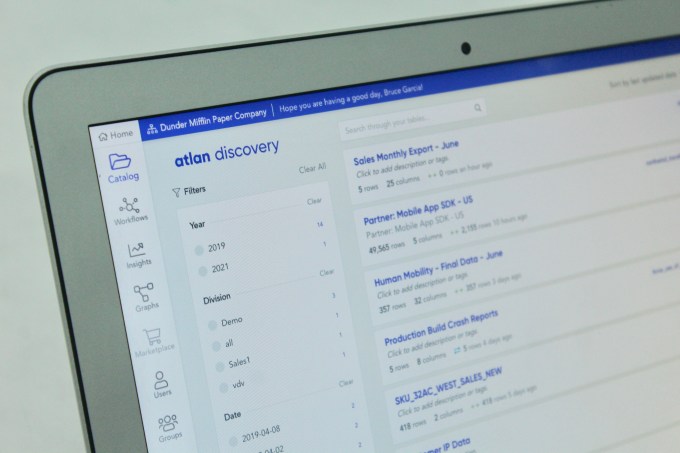
Teams within a typical company currently use a number of different tools to gather and manage data. Atlan has built products — dubbed Discovery, Grid, and Workflows — to create a collaboration layer, bringing together diverse data (from internal and external sources), tools and people to one interface.
“We are reimagining every human interaction with data. For instance, code has a profile on GitHub—what would a “profile” of data look like? What if you could share data as easily as a Google Sheets link, without worrying about the size or format? Or what would a data versioning and approval workflow look like? What if data scientists could acquire external data within minutes, instead of the months it takes right now?” said Banka.
The startup has also built a product called Collect that allows an organization to quickly deploy apps to collect granular data. These apps can collect data even when there is no internet connection. All of these data points, too, then find their way to the interface.
Atlan intends to use the capital it has raised on product development and sign more customers. It has already won some big names including Unilever, Milkbasket, Barbeque Nation, WPP and GroupM, Mahindra Group and InMobi in India, Chuan Lim Construction in Singapore, ServeHaiti in Haiti, Swansea University in the UK, the Ministry of Environment in Costa Rica, and Varun Beverages in Zambia.
In a prepared statement, Manish Kheterpal, Managing Partner at WaterBridge Ventures, said, “companies are struggling to overcome the friction that arises when diverse individuals need to collaborate, leading to project failure. The IPOs of companies like Slack and Zoom are proof that we live in the era of consumerization of the enterprise. With its sharp focus on data democratization, Atlan is well-positioned to reimagine the future of how data teams work.”
As for SocialCops, Sankar said it will live on as a data science community and pursue its signature “social good” mission.
Powered by WPeMatico
Samsung CEO calls Galaxy Fold mishap ‘embarrassing’
In a meeting with a group of journalists in South Korea, Samsung Electronics CEO DJ Koh candidly addressed the company’s latest hardware mishap. “It was embarrassing,” he told reporters, as quoted by The Independent. “I pushed it through before it was ready.”
That last bit no one can debate, really. After years of preamble, Samsung still managed to jump the gun with the Galaxy Fold. The company was eager to be the first major manufacturer to market with the category’s most radical redesign in a decade. Ultimately, however, the company ended up pumping the breaks after multiple reviewers reported problems with their units.
Samsung was quick to place the blame at the hands of reviewers, but eventually shifted course after realizing that problems were more widespread. More than two months after the handset was initially expected to hit retail, we’re still very much in a holding pattern with Samsung’s first foldable — though the company has promised a more concrete date for some time.
Samsung has been quick to deny any rumors that the phone has been altogether canceled, and Koh reiterated that the Fold is still being put through its paces. “I do admit I missed something on the foldable phone, but we are in the process of recovery,” the executive told the press. “At the moment, more than 2,000 devices are being tested right now in all aspects. We defined all the issues. Some issues we didn’t even think about, but thanks to our reviewers, mass volume testing is ongoing.”
Koh didn’t offer specifics with regards to a release date, though the company is reportedly gearing up to launch the next version of the Note at an event in August.
Powered by WPeMatico
Calm raises $27M to McConaughey you to sleep
Meditation app unicorn Calm wants you to doze off to the dulcet tones of actor Matthew McConaughey’s southern drawl or writer Stephen Fry’s English accent. Calm’s Sleep Stories feature that launched last year is a hit, with more than 150 million listens from its 2 million paid subscribers and 50 million downloads. While lots of people want to meditate, they need to sleep. The seven-year-old app has finally found its must-have feature that makes it a habit rather than an aspiration.
Keen to capitalize on solving the insomnia problems plaguing people around the world, Lightspeed tells TechCrunch it has just invested $27 million into a Series B extension round in Calm alongside some celebrity angels at a $1 billion valuation. The cash will help the $70 per year subscription app further expand from guided meditations into more self-help masterclasses, stretching routines, relaxing music, breathing exercises, stories for children and celebrity readings that lull you to sleep.

The funding adds to Calm’s $88 million Series B led by TPG that was announced in February that was also at a $1 billion valuation, bringing the full B round to $115 million and Calm’s total funding to about $141 million. Lightspeed partner Nicole Quinn confirms the fund started talks with Calm around the same time as TPG, but took longer to finish due diligence, which is why the valuation didn’t grow despite Calm’s progress since February.
“Nicole and Lightspeed are valuable partners as we continue to double down on entertainment through our content,” Calm’s head of communications Alexia Marchetti tells me. The startup plans to announce more celebrity content tie-ins later this summer.
Broadening its appeal is critical for Calm amidst a crowded meditation app market that includes Headspace, Simple Habit and Insight Timer, plus newer entrants like Peloton’s mindfulness sessions and Journey’s live group classes. It’s become easy to find guided meditations online for free, so Calm needs to become a holistic mental wellness hub.
While it risks diluting its message by doing so much, Calm’s plethora of services could make it a gateway to more of your personal health spend, including therapy, meditation retreats and health merchandise from airy clothing to yoga mats. But subscription fees alone are powering a big business. Calm quadrupled revenue in 2018 to reach $150 million in ARR and hit profitability.
Calm is poised to keep up its rapid revenue growth. After the launch of Sleep Stories, “it was incredible to see the engagement spike up and also the retention,” says Quinn. Users can choose from having McConaughey describe the wonders of the cosmos, John McEnroe walk them through the rules of tennis, fairy tales like The Little Mermaid and more.
Quinn tells me “Sleep Stories is now a huge percentage of the business, and also the length of time people spend on the app has gone up dramatically.” She tells me that so many startups are “trying to invent a problem where there isn’t one.” But difficulty snoozing is so widespread and detrimental that users are eager to pay for an app instead of a sleeping pill. Having the Interstellar actor talk about the universe until I pass out sounds alright, alright, alright.

Powered by WPeMatico
Video platform Kaltura adds advanced analytics
You may not be familiar with Kaltura‘s name, but chances are you’ve used the company’s video platform at some point or another, given that it offers a variety of video services for enterprises, educational institutions and video-on-demand platforms, including HBO, Phillips, SAP, Stanford and others. Today, the company announced the launch of an advanced analytics platform for its enterprise and educational users.
This new platform, dubbed Kaltura Analytics for Admins, will provide its users with features like user-level reports. This may sound like a minor feature, because you probably don’t care about the exact details of a given user’s interactions with your video, but it will allow businesses to link this kind of behavior to other metrics. With this, you could measure the ROI of a given video by linking video watch time and sales, for example. This kind of granularity wasn’t possible with the company’s existing analytics systems. Companies and schools using the product will also get access to time-period comparisons to help admins identify trends, deeper technology and geolocation reports, as well as real-time analytics for live events.
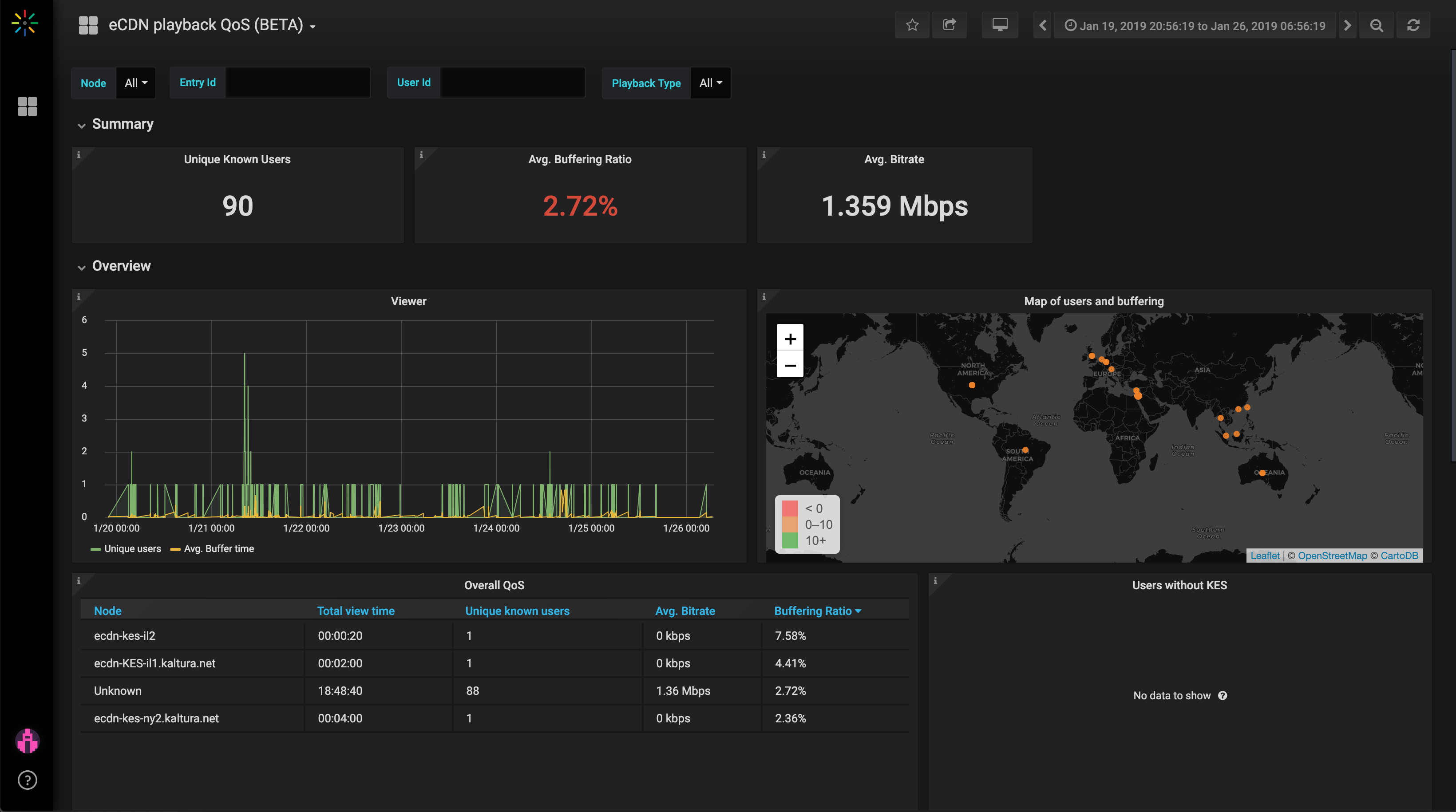
“Video is a unique data type in that it has deep engagement indicators for measurement, both around video creation — what types of content are being created by whom, as well as around video consumption and engagement with content — what languages were selected for subtitles, what hot-spots were clicked upon in video,” said Michal Tsur, president and general manager of Enterprise and Learning at Kaltura. “Analytics is a very strategic area for our customers. Both for tech companies who are building on our VPaaS, as well as for large organizations and universities that use our video products for learning, communication, collaboration, knowledge management, marketing and sales.”
Tsur also tells me the company is looking at how to best use machine learning to give its customers even deeper insights into how people watch videos — and potentially even offer predictive analytics in the long run.
Powered by WPeMatico
We’ll talk even more Kubernetes at TC Sessions: Enterprise with Microsoft’s Brendan Burns and Google’s Tim Hockin
You can’t go to an enterprise conference these days without talking containers — and specifically the Kubernetes container management system. It’s no surprise then, that we’ll do the same at our inaugural TC Sessions: Enterprise event on September 5 in San Francisco. As we already announced last week, Kubernetes co-founder Craig McLuckie and Aparna Sinha, Google’s director of product management for Kubernetes, will join us to talk about the past, present and future of containers in the enterprise.
In addition, we can now announce that two other Kubernetes co-founders will join us: Google principal software engineer Tim Hockin, who currently works on Kubernetes and the Google Container Engine, and Microsoft distinguished engineer Brendan Burns, who was the lead engineer for Kubernetes during his time at Google.
With this, we’ll have three of the four Kubernetes co-founders onstage to talk about the five-year-old project.
Before joining the Kuberntes efforts, Hockin worked on internal Google projects like Borg and Omega, as well as the Linux kernel. On the Kubernetes project, he worked on core features and early design decisions involving networking, storage, node, multi-cluster, resource isolation and cluster sharing.
While his colleagues Craig McLuckie and Joe Beda decided to parlay their work on Kubernetes into a startup, Heptio, which they then successfully sold to VMware for about $550 million, Burns took a different route and joined the Microsoft Azure team three years ago.
I can’t think of a better group of experts to talk about the role that Kubernetes is playing in reshaping how enterprise build software.
If you want a bit of a preview, here is my conversation with McLuckie, Hockin and Microsoft’s Gabe Monroy about the history of the Kubernetes project.
Early-Bird tickets are now on sale for $249; students can grab a ticket for just $75. Book your tickets here before prices go up.
Powered by WPeMatico
Analysts think global 5G smartphone shipments will overtake 4G in 2023
After years of buildup, 5G is finally here — albeit more as a trickle than a deluge. These things take time, of course. Carriers are adding coverage, city by city, promising dozens by year’s end. And as for hardware, early adopters have somewhere between one and three handsets to choose from, carrier-dependent.
Indeed, 5G is pretty universally regarded as the next key mobile trend, but it’s not going to happen overnight. A new report from Canalys has 2023 as the true pivot point, when 5G handset shipments finally overtake 4G. That’s roughly five years, with 2019 included. Of course, that’s the global number, and these things will almost certainly vary from market to market.
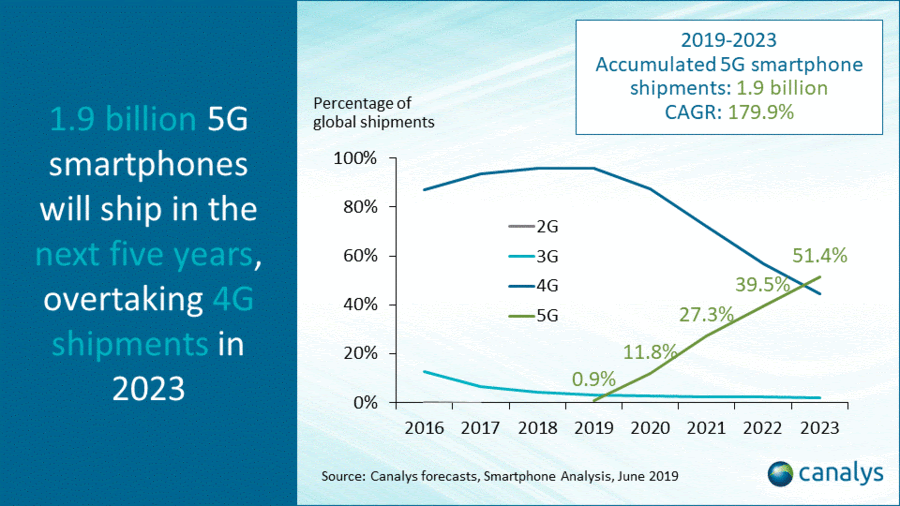
The firm has 5G phones hitting 800 million shipments in 2023, which will comprise 51.4% of the global market for the year. That will bring the total shipments up to 1.9 billion since the first 5G-capable devices were launched this year. North America will make up 18.8% of the market to Greater China’s 34%.
That’s big, continued growth for China, which surpassed the U.S. for the title of the largest smartphone market back in 2011. While the Chinese economy has slowed and taken its high-end smartphone market with it, the country is well-positioned to be an important player in the race to 5G.
“5G smartphones will see rapid adoption in China, thanks to a strong government technology roadmap and operators’ financial capabilities,” Canalys mobile VP Nicole Peng said in a statement. “China is also home to many major 5G equipment suppliers and smartphone vendors, which will be responsible for an aggressive marketing push over the next few years.”
Powered by WPeMatico
Higher Ground Labs is betting tech can help sway the 2020 elections for Democrats
When Shomik Dutta and Betsy Hoover first met in 2007, he was coordinating fundraising and get-out-the-vote efforts for Barack Obama’s first presidential campaign and she was a deputy field director for the campaign.
Over the next two election cycles the two would become part of an organizing and fundraising team that transformed the business of politics through its use of technology — supposedly laying the groundwork for years of Democratic dominance in organizing, fundraising, polling and grassroots advocacy.
Then came Donald J. Trump and the 2016 election.
For both Dutta and Hoover, the 2016 outcome was a wake-up call against complacency. What had worked for the Democratic party in 2008 and 2012 wasn’t going to be effective in future election cycles, so they created the investment firm Higher Ground Labs to provide financing and a launching pad for new companies serving Democratic campaigns and progressive organizations.
“As the political world shifts from analog to digital, we need a lot more tools to capture that spend,” says Dutta. “Democrats are spending on average 70 cents of every dollar raised on television ads. We are addicted to old ways of campaigning. If we want to activate and engage an enduring majority of voters we have to go where they are (and that’s increasingly online) and we have to adapt to be able to have these conversations wherever they are.”
Social media and the rise of “direct to consumer” politics
While the Obama campaign effectively used the internet as a mobilization tool in its two campaigns, the lessons of social media and mobile technologies that offer a “direct-to-consumer” politics circumventing traditional norms have, in the ensuing years, been harnessed most effectively by conservative organizations, according to some scholars and activists.
“The internet is a tool and in that sense it’s neutral, but just like other communication tools from the past, people with more power, with more resources, with more organization, have been able to take advantage of it,” Jen Schradie, an assistant professor at the Observatoire sociologique du changement at Sciences Po in Paris, told Vox in an interview earlier this month.
Schradie is a scholar whose recent book, “The Revolution That Wasn’t,” contends that the internet’s early application as a progressive organizing tool has been overtaken by more conservative elements. “The idea of neutrality seems more true of the internet because the costs of distributing information are dramatically lower than with something like television or radio or other communication tools,” she said. “However, to make full use of the internet, you still need substantial resources and time and motivation. The people who can afford to do this, who can fund the right digital strategy, create a major imbalance in their favor.”
Schradie contends that a web of privately funded think tanks, media organizations, talk radio and — increasingly — mobile applications have woven a conservative stitch into the fabric of social media. The medium’s own tendency to promote polarizing and fringe viewpoints also served to amplify the views of pundits who were previously believed to be political outliers.
Essentially, these sites have enabled commentators and personalities to create a patchwork of “grassroots” organizations and media operations dedicated to reaching an audience receptive to their particular political message that’s funded by billionaire donors and apolitical corporate ad dollars.
Then there’s the technology companies, like Cambridge Analytica, which improperly used access to Facebook data for targeting purposes — also financed by these same billionaires.
“The last six years have witnessed millions and millions of dollars of private Koch money and Mercer money that have gone to pretty sophisticated data and media efforts to advance the Republican agenda,” says Dutta. “I want to even the scale.”
Dutta is referring to Charles and David Koch and Robert Mercer, the scions and founder (respectively) of two family dynasties worth billions. The Koch brothers support a web of political advocacy groups, while Mercer and his daughter were large backers of Breitbart News and Cambridge Analytica, two organizations that arguably provided much of the policy underpinnings and online political machinery for the Trump presidential campaign.
But there’s also the simple fact that Donald Trump’s digital strategy director, Brad Parscale, was able to effectively and inexpensively leverage the social media tools and data troves amassed by the Republican National Committee that were already available to the candidate who won the Republican primary. In fact, in the wake of Romney’s loss, Republicans spent years building up profiles of 200 million Americans for targeted messaging in the 2016 election.
“Who controls Facebook controls the 2016 election,” Parscale said during a speaking engagement at the Romanian Academy of Sciences, according to a report in Forbes.
Parscale, now the campaign manager for the president’s 2020 reelection campaign recalled, “These guys from Facebook walked into my office and said: ‘we have a beta … it’s a new onboarding tool … you can onboard audiences straight into Facebook and we will match them to their Facebook accounts,’ ” according to Forbes .
During the 2016 campaign, Hillary Clinton’s team made 66,000 visual ads, according to Parscale, while the Trump campaign made 5.9 million ads by leveraging social media networks and the language of memes. And in the run-up to the 2020 election, Parscale intends to go back to the same well. The Trump campaign has already spent more than $5 million on Facebook ads in the current election cycle, according to The New York Times — outspending every single Democratic candidate in the field and roughly all of the Democrats combined.
Reaching higher ground
Dutta and Hoover are working to offset this movement with investments of their own. Back in 2017, the two launched Higher Ground Labs, an early-stage company accelerator and investment firm dedicated to financing technology companies that could support progressive causes.
The firm has $15 million committed from investors, including Reid Hoffman, the co-founder of LinkedIn and a partner at Greylock; Ron Conway, the founder of SV Angel and an early backer of Google, Facebook and Twitter; Chris Sacca, an early investor in Uber; and Elizabeth Cutler, the founder of SoulCycle. Already, Higher Ground has invested in more than 30 companies focused on services like advocacy outreach, polling and campaign organizing — among others.
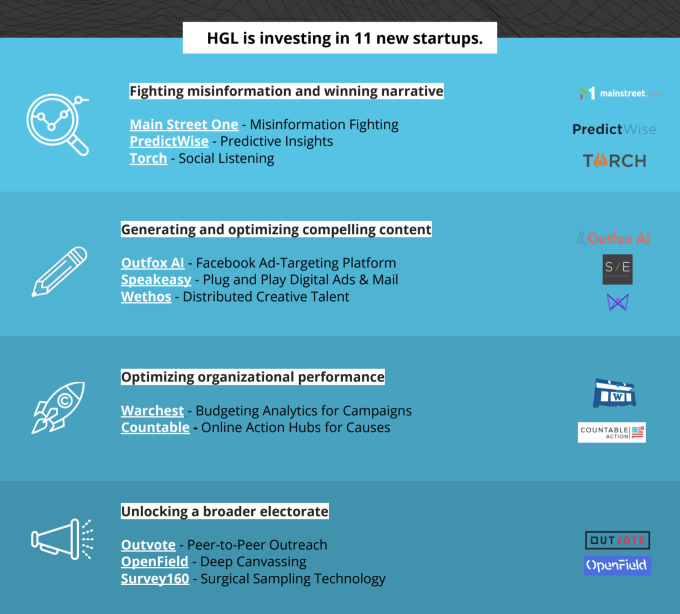
The latest cohort of companies to receive backing Higher Ground Labs
“It is vitally important that Democrats learn to do their campaigns online,” says Dutta. “The way you recruit volunteers; the way you poll sentiment; the way you target and mobilize voters has to be done with online tools and has to improve in the progressive movement and that’s the job of Higher Ground Labs to fix.”
For-profit companies have a critical role to play in election organizing and mobilization, Dutta says. Thanks to government regulation, only private companies are allowed to trade data across organizations and causes (provided they do it at fair market value). That means advocacy groups, unions and others can tap the information these companies collect — for a fee.
The Democratic Party already has one highly valued private company that it uses for its technology services. Formed from the merger of NGP Software and Voter Activation Network, two companies that got their start in the late 1990s and early 2000s, NGP VAN is the largest software and technology services provider for Democratic campaigns. It’s also a highly valued company, which received roughly $100 million in financing last year from the private equity firm Insight Venture Partners, according to people familiar with the investment. Terms of the deal were not disclosed.
“Our vision has been to build a platform that would break down the painful data silos that exist in the campaigns and nonprofit space, and to offer truly best-in-class digital, fundraising and organizing features that could serve both the largest and the smallest nonprofits and campaigns, all with one unified CRM,” wrote Stu Trevelyan, the chief executive of NGP VAN + EveryAction, in an August blogpost announcing the investment. “We’re so excited that others, like our new partners at Insight, share that vision, and we can’t wait to continue innovating and growing together in the coming years.”
Can startups lead the way?
Even as private equity dollars boost the firepower of organizations like NGP VAN, venture capitalists are financing several companies from the Higher Ground Labs portfolio.
Civis Analytics, a startup founded by the former chief analytics officer of Barack Obama’s 2012 reelection campaign, raised $22 million from outside investors, and counts Higher Ground Labs among its backers. Qriously, another Higher Ground Labs portfolio company, was acquired by Brandwatch, as was GroundBase, a messaging platform acquired by the nonprofit progressive advocacy organization ACRONYM.
Other companies in the portfolio are also attracting serious attention from investors. Standouts like Civis Analytics and Hustle, which raised $30 million last May, show that investors are buying into the proposition that these companies can build lasting businesses serving Democratic and progressive political campaigns and corporate businesses that would also like to rally employees or personalize a marketing pitch to customers.
These are companies like Change Research, an earlier-stage company that just launched from Higher Ground Labs accelerator last year. That company, founded by Mike Greenfield, a serial Silicon Valley entrepreneur who was the first data scientist working on the problem of fraud detection at PayPal, and Pat Reilly, a communications professional who worked with state and local Democratic politicians, is slashing the cost of political polling.
“I wanted to do something for American democracy to try and improve the state of things,” Greenfield said in an interview last year.
For Greenfield, that meant increasing access to polling information. He cited the test case of a Kansas special election in a district that Donald Trump had won by 27 points. Using his own proprietary polling data, Greenfield predicted that the Democratic challenger, James Thompson, would pose a significant threat to his Republican opponent, Mike Estes.
Estes went on to a 7% victory at the ballot, but Thompson’s campaign did not have access to polling data that could have helped inform his messaging and — potentially — sway the election, said Greenfield.
“Public opinion is used to ween out who can be most successful based on how much money they’re able to raise for a poll,” says Reilly. It’s another way that electoral politics is skewed in favor of the people with disposable income to spend what is a not-insignificant amount of money on campaigns.
Polls alone can cost between $20,000 to $30,000 — and Change Research has been able to cut that by 80% to 90%, according to the company’s founders.
“It’s safe to say that most of the world was stunned by the outcome [of the presidential election] because most polls predicted the opposite,” says Greenfield. “Being a good American and as a parent of a 10-year-old and a 12-year-old, providing forward-thinking candidates and causes with the kind of insight they needed to win up and down the ballot could not only be a good business, but really help us save our democracy.”
Change Research isn’t just polling for politicians. Last year, the company conducted roughly 500 polls for political candidates and advocacy groups.
“The way that I’ve described Change Research to investors is that we want to simultaneously move the world in a better direction and having a positive impact while building a substantial business,” says Greenfield. “We’re only going to work with candidates and causes that we’re aligned with.”
Being exclusively focused on progressive causes isn’t the liability that many in the broader business community would think, says Dutta. Many Democratic organizations won’t work with companies that sell services to both sides of the aisle.
For Higher Ground Labs, a stipulation for receiving their money is a commitment not to work with any Republican candidate. Corporations are okay, but conservative causes and organizations are forbidden.
“We’re in a moment of existential crisis in America and this Republican party is deeply toxic to the health and future of our country,” says Dutta. “The only path out of this mess is to vote Republicans out of office and to do that we need to make it easier for good candidates to run for office and to engage a broader electorate into voting regularly.”
Powered by WPeMatico
Tara.ai, which uses machine learning to spec out and manage engineering projects, nabs $10M
Artificial intelligence has become an increasingly important component of how a lot of technology works; now it’s also being applied to how technologists themselves work. Today, one of the startups building such a tool has raised some capital, Tara.ai, a platform that uses machine learning to help an organization get engineering projects done — from identifying and predicting the work that will need to be tackled, to sourcing talent to execute that, and then monitoring the project of that project — has raised a Series A of $10 million to continue building out its platform.
The funding for the company cofounded by Iba Masood (she is the CEO) and Syed Ahmed comes from an interesting group of investors that point to Tara’s origins, as well as how it sees its product developing over time.
The round was led by Aspect Ventures (the female-led firm that puts a notable but not exclusive emphasis on female-founded startups) with participation also from Slack, by way of its Slack Fund. Previous investors Y Combinator and Moment Ventures also participated in the round. (Y Combinator provides an avenue to companies from its cohorts to help them source their Series A rounds, and Tara.ai went through this process.)
Tara.ai was originally founded as Gradberry out of Y Combinator, with its initial focus on using an AI platform for organizations to evaluate and help source engineering talent: Tara.ai was originally that name of its AI engine.
(The origin of how Masood and Ahmed identified this problem was through their own direct experience: both were grads (she in finance, he in engineering) from the American University of Sharjah in the U.A.E. that had problems getting hired because no one had ever heard of their university. Even so, they had won an MIT-affiliated startup competition in Morocco and relocated to Boston. The idea with Gradberry was to cut through the big names and focus just on what people could do.)
Masood and Syed (who eventually got married) eventually realised that using that engine to evaluate the wider challenges of executing engineering projects came as a natural progression once the team started digging into the challenges and identifying what actually needed to be solved.
A study that McKinsey (where Masood once worked) conducted across some 5,000 projects found that $66 billion dollars were identified as “lost” due to projects running past the expected completion time, lack of adequate talent and just overall poor planning.
“We realised that recruiting was actually the final decision you make, not the first, and we wanted to be involved earlier in the decision-making process,” Masood said in an interview. “We saw a much bigger opportunity looking not at the people, but the whole project.”
In action, that means that Tara.ai is used not just to scope out the nature of the problem that needed to be solved, or the goal that an organization wanted to achieve; it is also used to suggest which frameworks will need to be used to execute on that goal, and then suggest a timeline to follow.
Then, it starts to evaluate a company’s own staff expertise, along with that from other recruiting platforms, to figure out which people to source from within the company. Eventually, that will also be complemented with sourcing information from outside the organization — either contractors or new hires.
Masood noted that a large proportion of users in the tech world today use Jira and platforms like it to manage projects. While there are some tools in Jira to help plan out projects better, Tara is proposing its platform as a kind of virtual project manager, or an assistant to an existing project manager, to conceive of the whole project, not just help with the admin of getting it done.
Notably, right now she says that some 75% of Tara.ai’s users — customers include Cisco, Orange Silicon Valley and Mower Digital — are “not technical,” meaning they themselves do not ship or use code. “This helps them understand what could be considered and the dependencies that can be expected out of a project,” she notes.
Lauren Kolodny, the partner at Aspect who led the investment, said that one of the things that stood out for her, in fact, with Tara.ai, was precisely how it could be applied exactly in those kinds of scenarios.
Today, tech is such a fundamental part of how a lot of businesses operate, but that doesn’t mean that every business is natively a technology one (think here of food and beverage companies as an example, or government agencies). In those cases, these companies would have traditionally had to turn to outside consultants to identify opportunities, and then build and potentially long-term operate whatever the solutions become. Now there is an opportunity to rethink how technology is used in these kinds of organizations.
“Projects have been hacked together from multiple systems, not really built in combination,” Kolodny said of how much development happens at these traditional businesses. “We are really excited about the machine learning scoping and mapping of internal and external talent, which is looking to be particularly important as traditional enterprises are required to get level with newer businesses, and the amount of talent they need to execute on these projects becomes challenging.”
Tara.ai’s next steps will involve essentially taking the building blocks of what you can think of as a very powerful talent and engineering project search engine, and making it more powerful. That will include integrating databases of external consultants and figuring out how best to have these in tandem with internal teams while keeping them working well together. And soon to come also will be bug prediction: how to identify these before they arise in a project. The company is releasing an updated AI engine to coincide with the funding.
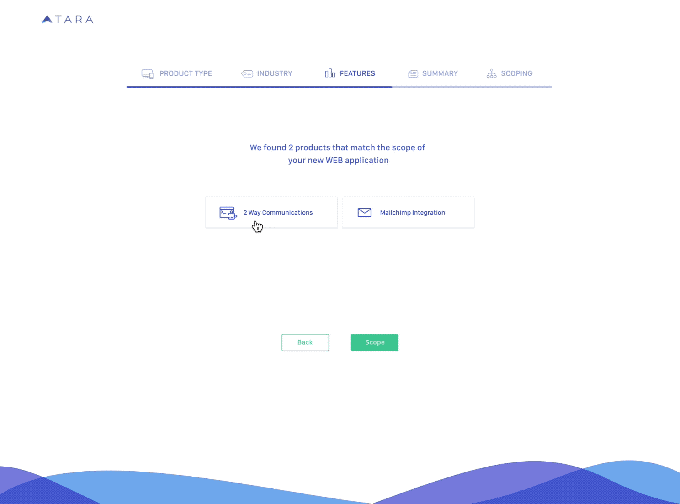
The Slack investment is also a notable nod to what direction Tara.ai will take. Masood said that Slack was one of three “big tech” companies interested in investing in this round, and she and Syed chose Slack because from what they could see of its existing and target customers, many were already using it and some have already started requesting closer collaboration so that events in one could come up as updates in the other.
“Our largest customers are heavy Slack users and they are already having conversations in Slack related to projects in Tara.ai,” she said. “We are tackling the scoping element and now seeing how to link up even command line interfaces between the two.”
She noted that this does not rule out closer integrations with communications and other platforms that people use on a daily basis to get their work done: the idea is to become a tool to work better overall.
Powered by WPeMatico

